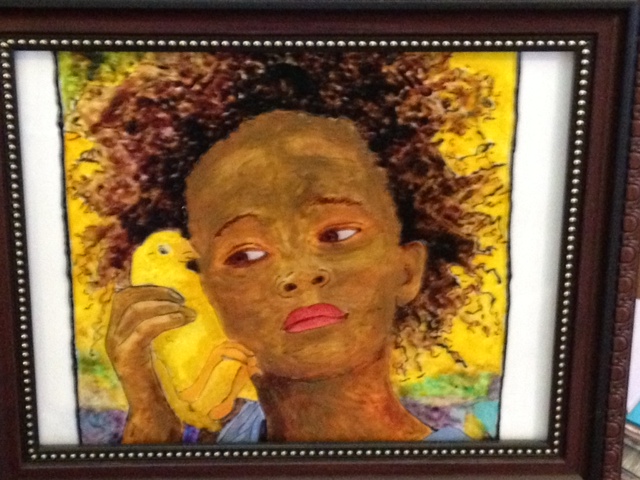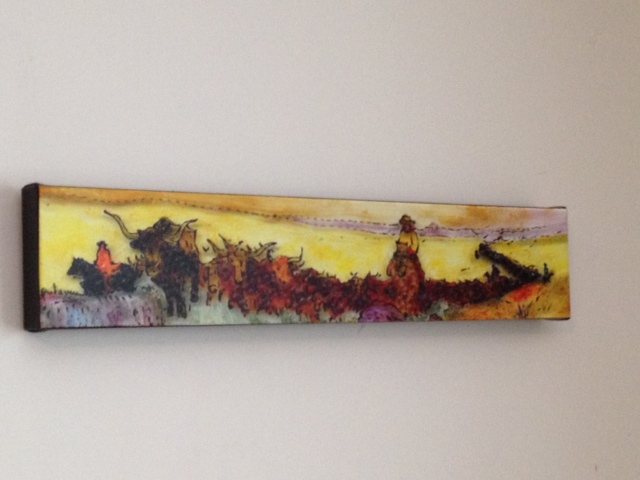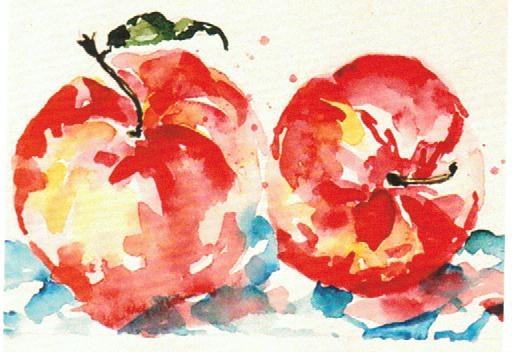 An artist makes many connections in his life. He ages, collecting images and sounds; he meets new friends and bonds with family; he gains inspiration from the world outside and around him. The mind of an artist is a rich garden, and, if properly tended, it will bear seed and grow. The garden that Phil Strang tends is an extensive one, filled with vibrant colors. It is self-sustaining and ever-changing. He describes his own colorful paintings with wonder and enthusiasm: “They’re alive!”
An artist makes many connections in his life. He ages, collecting images and sounds; he meets new friends and bonds with family; he gains inspiration from the world outside and around him. The mind of an artist is a rich garden, and, if properly tended, it will bear seed and grow. The garden that Phil Strang tends is an extensive one, filled with vibrant colors. It is self-sustaining and ever-changing. He describes his own colorful paintings with wonder and enthusiasm: “They’re alive!”
Strang’s upcoming, collaborative exhibit, “Three Ways to Get Here,” opens this Friday at Indi Go Artist Co-op in downtown Champaign. The exhibit features three artists, including Strang, who works for the University of Illinois, managing Foellinger Auditorium and Lincoln Hall Theatre. The photographer, Cecil Bilbo, works at Parkland College. Sally Walsch works at Richland Community College and works with ceramics and watercolors.
I got to talk to Phil Strang over email for several days and visited his home — stuffed to the rafters with finished pieces — to see his workspace and preview his paintings.
Smile Politely: I’ve always been jealous of of artists of the painting variety. How did you start? Where does a person begin?
Phil Strang: I had a wonderful art teacher in 8th grade at Campbell Jr. High School in Flushing, Queens. She encouraged us to draw and create, and I won a contest to paint a mural on the hallway wall across from the school library. I painted a scene from Romeo and Juliet; it took me six weeks, two hours a day after school, to finish it. That painting gave me great confidence … that painting was there for over thirty years before they finally painted over it.
The only thing keeping me from deciding to be an artist was that everything took me so long. So I kept art on the back burner for years.
I actually did all the advertising for Record Service for thirty years. Often, I would hire high school students (Michael Jantzen, Gabriel Usadel, Nina Paley) to do the artwork for the ads. When Record Service went out of business in March 2004, I started painting 4–6 hours every day on glass, because we had hundreds of pieces of glass lying around. Within nine months I had painted over 120 pieces and did my first show. It’s amazing what you can learn by just doing it.
SP: I like that! Just BE an artist! What will we see at this exhibition you’re having?
Strang: The exhibit will be June 26 through July 6 at indi go Artist Co-op. Since each of our paths was so divergent to get to this point (both literally and figuratively) and on several other levels as well, we have named the exhibit “Three Ways to Get Here.” Cecil is a photographer … Sally Walsh works in watercolors. I paint on glass and also make Giclee prints from these paintings.
We each will be showing 35–50 works and we will also have receptions with music, food, and drinks on three of the nights. For the opening night reception, which will be 6–9 p.m. on Friday, June 28, right in the midst of Friday Night Live, we will have Dublin O’Neil’s serving free appetizers. [There will be] a cash bar with music by Bruiser and the Javelinas, as well as a later set by John McMahon.
On July 3 (also 6–9 p.m.), we will have a red, white, and blue reception to help celebrate Independence Day with music by Cody and the Gateway Drugs, as well as a solo set by Cody Sokolski.
Then, for the third reception, which will be for the closing night (on Saturday, July 6 from 6-9 p.m.), we will have music by David Howie. We want to make the whole week a celebration of music and art, and [we] really hope people will come out and hang out and look around.

SP: What are the regular hours of the exhibit?
Strang: We will also be open 2–9 p.m. every day from the 29th on (except for the 4th of July).
SP: What is your painting style? I’ve seen your work online and it comes from Second Life…? Is that right?
Strang: About two-thirds of the paintings I will be showing are portraits of avatars I have met in the world of Second Life. (Second Life is an interactive virtual world with thousands of people from all over the world who each have avatars that represent themselves). As we like to say … many of these are just younger, thinner versions of ourselves. But the truth is that there is greater variety than that.
In the world of Second Life, I am Van Caerndow, and I am a portrait artist. I work on commission and various people hire me to paint their avatars. I charge a nominal fee (5,000 Lindens or about $20) and, after I paint real life paintings of them on glass, I scan and download it for them. They get a pixelated version to put in the home or gallery in Second Life.
SP: What happens to the originals?
Strang: Sometimes they buy the real life original or the Giclee print of it. At the exhibit at indi go, I will be showing both originals on glass as well as 9” by 12” prints of them.
SP: How did you think of the Second Life painting process?
Strang: Someone told me there were many artists and musicians involved in [Second Life] and it was a good way to show work [to] an international audience. So I slowly involved myself and learned the technology and figured out how to show my artwork within Second Life. It was about nine months before I thought about painting the people and places I saw there. The helpful part is that there is an in-world camera within Second Life, so I could take pictures wherever I went and could then use those as the models for paintings.

SP: What do you use — other than the computer and ‘game’ itself?
Strang: Well, [I want to] be clear that not all of my paintings are of Second Life avatars and places. I also have done done some paintings on canvas in the past year, and that has been a new type of challenge.
When it comes to painting on glass, I usually buy a $3 frame … and take out the glass and paint on that. Then, after the painting is done and baked, I can put it back in the frame to show it. I work on an old desk with about 90 bottles of Pebeo paint in front of me and a small mixing palette by my left side, and a rack of 30–40 tiny paint brushes on my right. (I use a size 2 at the largest, down to some that are 1/20, which are the smallest.) I usually have a printout of whatever picture I am using for my model. Of course I am not trying to match things exactly … just using them as a reference.

SP: How long does the process take from drawing, painting, baking, to finishing and framing?
Strang: I usually figure about one week to take the pictures (sometimes as many as 200) and then review them and pick the ones I like best; crop and color-correct until I get a composition I like. The average painting takes me about two weeks from when I start it until it is finished, baked, and scanned (professionally at Dixon Graphics).
I see the process as 20% of the time to draw it on glass, then the next 40% is painting the first coat. Then 30% is the second coat with shading and lighting. The final 10% is fine details and fixing up holes or mistakes.
SP: And how did you know your fellow exhibitionists? (I’m sure that’s the wrong usage, but I’m going with it, Phil.)
Strang: I met Cecil Bilbo on Facebook first and then about eighteen months, we met in real life. We crossed paths several times in the past year and, when James Barham asked if I would be interested in doing a show with Cecil, I said, ‘Definitely!’ Then Cecil suggested Sally Walsh as a third party, and so our trio was created.
Three very different artists coming from very different directions meeting for ten days at indi go gallery…

SP: I’ve seen your work, but what about Sally and Cecil? What do they offer that complete the exhibit?
Strang: I had been seeing Cecil’s photos on Facebook for a while. I liked his sunsets and rural scenes and thought it would be fun to do a painting of one of his photos. Sally teaches art, and not only does some very cool ceramics, but is an excellent watercolorist.
I figured we would blend well together and not step on each other’s toes. We complement and compliment each other.
~~*~~
When I examined Phil’s work up-close, he pointed out something that can’t really be observed online. He paints some far-away details on the back of the glass, then, on the front, he layers over the background color. This technique creates winding rivers, rolling fields, and starry nights with sparkling depth and texture.
Another fun Easter Egg to look for in Strang’s work is little more than an amusing, personal game. He paints, somewhere in each work, his initials (PAS). Some are kind of obvious while others are woven into the folds of a dress or creases in an awning. Look for them yourself at the Indi Go show! It’s really kind of fun!
The Facebook event is updated all the time with new pictures and information. Be sure to check it out before you visit the gallery!








